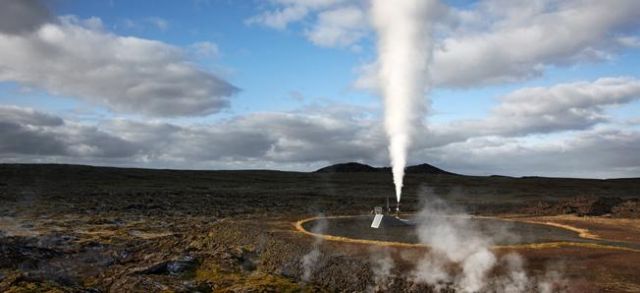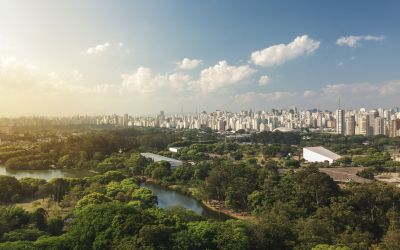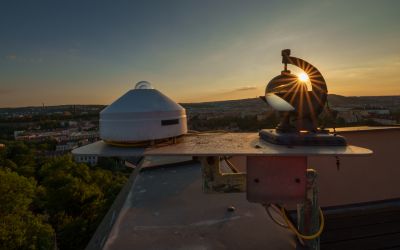Lisa Rhodes on carbon neutral solutions in the data centre industry
Verne Global owns and operates a data centre campus in Iceland and offers 100% carbon neutral solutions through a range of server density options and energy efficient techniques. Lisa Rhodes, Vice President of Corporate Strategy and Market Development at Verne Global discussed the key topics in the industry with Climate Action.

Verne Global owns and operates a data centre campus in Keflavik, Iceland and offers 100% carbon neutral and affordable power solutions through a range of server density options and energy efficient techniques. Lisa Rhodes, Vice President of Corporate Strategy and Market Development at Verne Global, discussed the key topics in the industry with Climate Action.
Can you tell us the story behind why VG was founded and with renewable power options across a multitude of countries, what inspired the team behind it to base the data-storage facility specifically in Iceland?
In 2007 we set out to solve the biggest problems facing the data centre industry, all of which relate to power.
The outsourced data centre industry is worth $12BN and growing, and is estimated to consume approximately 1.5% of all electricity generated in industrialised countries. This is expected to create more carbon emissions than the aviation industry by 2020.
As a result, data centre service providers face serious issues related to both carbon emissions and rising electricity prices.
By marrying Iceland’s competitively priced 100% renewable power with innovative power efficiency technologies and substantial industry expertise, Verne is helping firms to cut carbon emissions, lower TCO and remove operational risks associated with fluctuating power prices.
Broadly, what are the benefits of out-sourcing your data to a data storage centre like VGs?
Ours is the only data centre that uses primary and secondary electricity generated entirely by renewable power. Emitting zero carbon and running at least 40% more efficiently than a standard data centre, we’re allowing customers to minimise their carbon footprint.
At the same time, our customers reduce TCO savings due to Iceland’s low cost of energy. Our ability to offer visibility into pricing for up to 15 years reduces risk, allowing businesses to have long-term insight into their data centre costs.
Can you give us some facts and figures on the scale of the existing data-storage requirement globally, and the capacity VG can provide to the international ‘data-using’ community?
Global volumes of data are increasing at an exponential rate. Improvements in storage technology have made it possible to store quantities of data that would be thought impossible only a few years ago. Coupled with this, improvements in the reliability, capacity and speed of fixed and mobile internet connections are driving greater demand for more and more content. To give you an idea of scale, roughly 2.5 million PC hard-drives worth of data is created each day – which of course has to be stored somewhere. We’ve produced this infographic which includes facts like this and illustrates the growth in data and the power demands this is creating.
Put simply, the more data you need to store, the more it will cost you – both in terms of electricity and, if you’re connected to a traditional power grid, carbon. We can help firms to cut both.
At a practical level, what are the steps, and how easy is it, for a potential client to get connected to VG’s facilities and start storing data?
It’s very simple. There is currently space available within the data centre for new customers to install their own server equipment, and we have local partners to source and install equipment on behalf of customers too. The data centre is already connected to the rest of the world via several, high-speed sub-sea cables so new customers can get up and running with us very quickly.
One of VG’s most high-profile clients is BMW-Group. Can you explain how this relationship was established and how you’ve helped, and are helping BMW-Group?
BMW Group is using Verne Global’s data centre facility in Iceland for a number of its power-hungry high performance computing (HPC) applications. These include crash simulations, aerodynamic calculations and computer aided design and engineering (CAD/CAE), all of which are critical to the development of BMW’s next generation of energy efficient vehicles.
By moving ten of its HPC clusters (consuming 6.31 GW-h annually) from its German facilities to our data centre, BMW will reduce annual carbon emissions by 3,570 metric tonnes. To put this into perspective, that’s equivalent to the carbon produced by burning 1.46 million litres of petrol. The move also enables BMW to reduce the cost of powering its HPC applications by as much as 82 percent.
"BMW will reduce annual carbon emissions by 3,570 metric tonnes"
Could you provide some detail on the energy efficient measures VG has put in place at your facilities in Iceland? For example, what energy efficient technology and procedures are in place in terms of power, space and cooling systems for the facilities?
In addition to drawing its electricity supply from Iceland’s geothermal and hydroelectric power grid, there are some added benefits to locating the data centre in Iceland.
Because the climate in Iceland is generally very cool, it’s been possible for us to construct the data centre without the need for air chillers – a key component in traditional data centre builds. Temperature regulation is important as the servers must not be allowed to overheat. Air chillers are expensive to run so, without them, our customers have lower energy bills.
For prospective new-users, would you agree there is an element of education and awareness that needs to be conducted to explain the very basics as to what a data-storage centre is, what it does, and why it’s important in terms of its impact on sustainability? How are you doing this?
Verne Global has produced an informative animation to help educate people on the business and environmental impacts of the data centre industry, which you can watch on YouTube here. There is a long way to go before the data centre industry as a whole can become more sustainable, but we are already enabling businesses to immediately cut carbon emissions associated with their data storage needs.
Are large data-users within emerging and developing world nations also able to take advantage of VG’s services? Could you give us an example of your work with clients/nations in these regions?
Broadly, yes. Anyone one can take advantage of our services for all but the most latency–critical applications.
The data centre is connected to the rest of the world via some of the most high-capacity, multi-terabit-per-second connections which include FARICE-1, DANICE and GREENLAND CONNECT. The facility is 20 milliseconds from both London and Paris and 41 milliseconds from New York. At that latency applications like disaster recovery, cloud computing, research computing, database hosting and general business applications are all possible.
"The facility is 20 milliseconds from both London and Paris and 41 milliseconds from New York"
What security measures and technologies does VG have in place to ensure the data at the facility is 100% secure from unauthorised access?
In short – lots! There are nine “challenge points” to reach the data centre, with
multiple mantraps. There’s a single point of entry with 24x7 manned security and CCTV. There is no access without prior written approval. Any deliveries are via a secure truck trap, plus lots more... There’s a more detailed list of the security measures in place on our company fact sheet.
Broadly, what best practices can data centres elsewhere learn from VGs experiences in Iceland?
The quantities of data that businesses want to store and process are going to continue to rise. This is going to keep driving an unsustainable demand for infrastructure and power. Verne Global’s mission is to help businesses halt this, and prevent data centres from contributing to carbon emissions and the associated environmental impact that this has.
The data centre industry is going to come under increasing scrutiny for the impact that operations are having on the environment and any move towards more responsible business practices needs to be explored.
Lastly, out of interest, where does the name ‘Verne Global’ come from?
The name essentially came out of a brainstorming session that led to thinking of the author Jules Verne, whose book “Journey to the Center of the Earth” takes place in Iceland. A second book, also written by Jules Verne called “Twenty Thousand Leagues under the Sea” also reminded the founders of the importance of the under sea cables to the business proposition.






